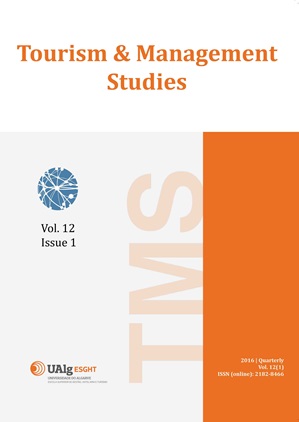Co-authorship networks: Collaborative research structures at the journal level
Keywords:
co-authorship networks, collaborative research, research networks, bibliometric analysis, journal analysisAbstract
Present-day research is, in most cases, the outcome of collaborative research, as evidenced by the fact that most papers are authored by two or more researchers. This study’s general goal was to examine the evolution and structure of scientific collaborative networks revealed by papers published in the Tourism & Management Studies journal over a five-year period, from 2011 to 2015, as well as to represent these networks graphically. In this paper, we seek to offer a clear assessment of intra-institutional, inter-institutional and international collaborations and to identify primary author networks and the role of gender in their composition. To reach these goals, we used a combination of bibliometric analysis with social network analysis. The results demonstrate that geographic proximity and linguistic affinity play a substantial role in scientific collaboration between institutions. In fact, most papers result from collaborative research involving two or more authors from the same institution. A gender analysis of the universe of authors and co-authors and of the role of women in the composition of co-authorship networks demonstrated that most networks include women and that, in most networks, women have a leading position, which is consistent with their weight (51.3%) in the universe of authors. This is one of the first studies to demonstrate that women are taking the lead in tourism and management research.References
Abbasi, A., Hossain, L., Uddin, S. & Rasmussen, K. J. R. (2011). Evolutionary dynamics of scientific collaboration networks: Multi-levels and cross-time analysis. Scientometrics, 89, 687 –710.
Day, R. & Gastel, B. (2012). How to write and publish a scientific paper. Cambridge: Cambridge University Press.
American Psychological Association (2013). Publication Manual of the American Psychological Association, Sixth Edition. Washington DC: American Psychological Association.
Chinchilla-Rodríguez, Z., Moya-Anegón, F., Vargas-Quesada, B., Corera-Álvarez, E. & Hassan-Montero, Y. (2008). Inter-institutional scientific collaboration: An approach from social network. In Prime Europe-Latin American Conference on Science and Innovation Policy 2008 (pp. 24 –26). Mexico City: Shawn Harmon School of Law.
Crane, D. (1972). Invisible Colleges. Chicago: University of Chicago Press.
Cimenler, O., Reeves, K. A. & Skvoretz, J. (2014). A regression analysis of researchers’ social network metrics on their citation performance in a college of engineering. Journal of Informetrics, 8, 667–682.
Du, H., Li, N., Brown, M. A., Peng, Y. & Shuai, Y. (2014). A bibliographic analysis of recent solar energy literatures: The expansion and evolution of a research field. Renewable Energy, 66, 696–706.
Figueroa-Domecq, C., Pritchard, A., Segovia-Pérez, M., Morgan, N. & Villacé-Molinero, T. (2015). Tourism gender research: A critical accounting. Annals of Tourism Research, 52, 87–103.
Grandjean, Martin (2015). GEPHI: Introduction to network analysis and visualization. Retrieved January 22, 2016 from http://www.martingrandjean.ch/gephi-introduction.
Katz, Sylvan & Martin, Ben R. (1997). What is research collaboration? Research Policy, 26, 1–18.
Newman, N. M. J. (2004). Coauthorship networks and patterns of scientific collaboration. PNAS, 101(1), 5200–5205. doi: 10.1073/pnas.0307545100
Hara, N., Solomon, P., Kim, S. L. & Sonnenwald, D. H. (2003). An emerging view of scientific collaboration: Scientists’ perspectives on collaboration and factors that impact collaboration. Journal of the American Society for Information Science and Technology, 54(10), 952–965.
Kretschmer, H. (1993). Measurement of social-stratification – A contribution to the dispute on the Ortega Hypothesis. Scientometrics, 26(1), 97–113.
Kyvik, S. & Larsen, I. M. (1994). International Contact and Research Performance. Scientometrics, 29(1), 161–172.
Luukkonen, T., Persson, O. & Sivertsen, G. (1992). Understanding patterns of international scientific collaboration. Science, Technology and Human Values, 17(1), 101–126.
Perc, M. (2010). Growth and structure of Slovenia’s scientific collaboration network. Informetrics, 4, 475–482.
Price, D. de S. (1986). Little science, big science … and beyond. New York: Columbia University Press.
Rodway, J. (2015). Connecting the dots: Understanding the flow of research knowledge within a research brokering network. Education Policy Analysis Archives, 23(123), 1–23. doi: 10.14507/epaa.v23.2180.
Santos, M. C. (2012). A importância da paisagem cultural para a competitividade dos destinos [The importance of cultural landscape for the competitiveness of destinations] (Unpublished doctoral dissertation). University of Aveiro, Aveiro, Portugal.
Sonnenwald, Diane H. (2007). Annual Review of Information Science and Technology, 41(1), 643–681.
Stevens, M. J., & Campion, M. A. (1994). The knowledge, skill, and ability requirement for teamwork: Implications for human resource management. Journal of Management, 20, 503–530.
Swain, M. B. (1995). Gender in Tourism. Annals of Tourism Research, 22(2), 247–266.
Wagner, C. S. & L. Leydesdorff (2005). Network structure, self-organization, and the growth of international collaboration in science. Research Policy, 34(10), 1608–1618.
Downloads
Published
Issue
Section
License
Copyright (c) 2016 Tourism & Management Studies

This work is licensed under a Creative Commons Attribution-NoDerivatives 4.0 International License.
The journal retains published articles’ copyrights, but they are simultaneously licensed under the Creative Commons Attribution License (CC BY-NC-ND), which allows individuals’ to share the relevant papers as long as authorship and publication in this journal are duly acknowledged.



